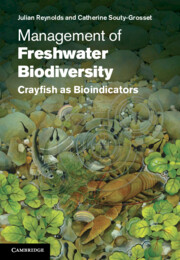Book contents
- Frontmatter
- Contents
- Preface
- Acknowledgements
- Introduction: Biodiversity in freshwater systems, and the key roles played by crayfish
- Part I The present situation of crayfish in world freshwater ecosystems
- 1 Crayfish in the decapod lineage, their natural distribution and their threatened status
- 2 Why are crayfish, among freshwater decapods, considered pivotal in freshwater ecosystems?
- 3 Crayfish as prime players in ecosystems
- 4 Human-mediated threats to crayfish survival
- 5 Crayfish exploitation systems
- Part II Applying science to conservation management
- Part III Knowledge transfer for successful crayfish management
- References
- Glossary
- Index
- Scientific and common English names of well-studied crayfish featured in this book
- Common English and scientific names of well-studied crayfish featured in this book
- Plate section
1 - Crayfish in the decapod lineage, their natural distribution and their threatened status
from Part I - The present situation of crayfish in world freshwater ecosystems
Published online by Cambridge University Press: 05 December 2011
- Frontmatter
- Contents
- Preface
- Acknowledgements
- Introduction: Biodiversity in freshwater systems, and the key roles played by crayfish
- Part I The present situation of crayfish in world freshwater ecosystems
- 1 Crayfish in the decapod lineage, their natural distribution and their threatened status
- 2 Why are crayfish, among freshwater decapods, considered pivotal in freshwater ecosystems?
- 3 Crayfish as prime players in ecosystems
- 4 Human-mediated threats to crayfish survival
- 5 Crayfish exploitation systems
- Part II Applying science to conservation management
- Part III Knowledge transfer for successful crayfish management
- References
- Glossary
- Index
- Scientific and common English names of well-studied crayfish featured in this book
- Common English and scientific names of well-studied crayfish featured in this book
- Plate section
Summary
The place of crayfish among decapod crustaceans
Arthropods are undeniably the most successful animal group on Earth. When only terrestrial arthropods are considered, insects, spiders, mites and myriapods are almost ubiquitous, but in fact crustaceans are the most widely distributed group among the arthropods. They are at home in the sea, in fresh waters and in moist areas on land (notably crabs, isopod woodlice and some amphipods), limited only by their requirements for gas exchange, excretion and osmoregulation. No other group of animals or plants on the planet exhibits the range of morphological diversity seen among the extant Crustacea (Martin & Davis, 2001), of which there are an estimated 50000–67000 species. The group also includes the largest of the mobile invertebrates – some crabs, clawed and spiny lobsters, and freshwater crayfish may reach several kilograms in weight, and some stone crabs have leg spans of more than two metres. At the other end of the spectrum are parasitic barnacles and copepods and tiny parthenogenic cladocerans less than one millimetre in total length. Such diversity also has its parallel in the range of habitats exploited, making the Crustacea ideal for any study of biodiversity.
Class Malacostraca
Class Malacostraca, the largest and most advanced group (containing more than 23000 species), includes almost all large and edible crustaceans, also the smaller but very abundant Peracarida (Isopoda, Amphipoda) and mysids as well as stomatopods (mantis shrimps) and euphausiids (krill).
- Type
- Chapter
- Information
- Management of Freshwater BiodiversityCrayfish as Bioindicators, pp. 17 - 44Publisher: Cambridge University PressPrint publication year: 2011



